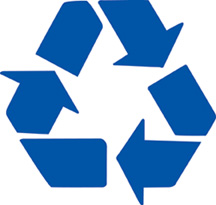 One of the most important parts of the recycling process is buying products made from recycled materials. By purchasing recycled-content products, you are helping to maintain market demand for recyclables, and ensure the continuation of recycling programs everywhere.
One of the most important parts of the recycling process is buying products made from recycled materials. By purchasing recycled-content products, you are helping to maintain market demand for recyclables, and ensure the continuation of recycling programs everywhere.
The Three Chasing Arrows
Each arrow in the recycling logo, or mobius, represents one step in the three-step process that completes the recycling loop.
- The first arrow represents the collection of recyclable materials.
- The second arrow represents the manufacturing process that converts recyclable materials into new products.
- The third step is where you, the consumer, purchase products made using recycled content, and recycle them again.
Economic Benefits of Recycling
A 2001 study, commissioned by the National Recycling Coalition, shows that the recycling industry contributes to the U.S. manufacturing base in the following ways:
- More than 56,000 public and private sector sales
- 1.1 million jobs
- $236 billion in gross annual sales
- $37 billion in payroll
- The recycling industry is comparable in size to the auto and truck manufacturing industry, and significantly larger than mining, waste management or disposal industries.
Environmental Benefits of Recycling
Recycling saves energy, natural resources, and landfill space. In most cases, making products from recycled materials also results in less air and water pollution than does making products from virgin materials.
Products Packaged in Recyclable Materials
ALUMINUM (cans) - soda, juice, beer
GLASS (jars) - pickles, baby food, jam, jelly
PAPER/CARDBOARD - milk, juice, toys
PLASTIC (containers) - milk, mouthwash, shampoo, soft drinks, juice, cough syrup
STEEL/TIN (cans) - soup, vegetables, fruits, pet food, coffee
What products are packaged in recycled materials?
Many companies use recycled materials in their product packaging. Examples not only include those listed above, but also boxes for cereal, cake mixes, various snacks, laundry detergent, and plastic bottles for cleaning products and liquid detergent.
What products are made from recycled materials?
AUTOMOTIVE supplies such as antifreeze, auto parts, batteries (lead acid), car mats, lubricating oil and grease, motor oil and tires.
CONSTRUCTION materials such as acoustical tiles, building insulation, ceiling tiles, dry wall, floor tiles, paint and plastic lumber.
OUTDOOR products such as compost bins, curb edging, flower/nursery pots and playground equipment.
PAPER products including boxes/cartons, business cards, computer paper, envelopes, letterhead, file folders, report covers, writing pads, napkins, facial tissue, toilet tissue, towels, wrapping paper, newsprint and copier paper
PLASTIC products including bags (grocery/shopping), carpeting, cleaning equipment (brooms, dust pans), car curb stops, clothing (shirts, jackets), garbage can liners, park benches, picnic tables, recycling bins and trash containers
MISCELLANEOUS items such as laser printer toner cartridges, pencils, pens, traffic safety cones, and toys
